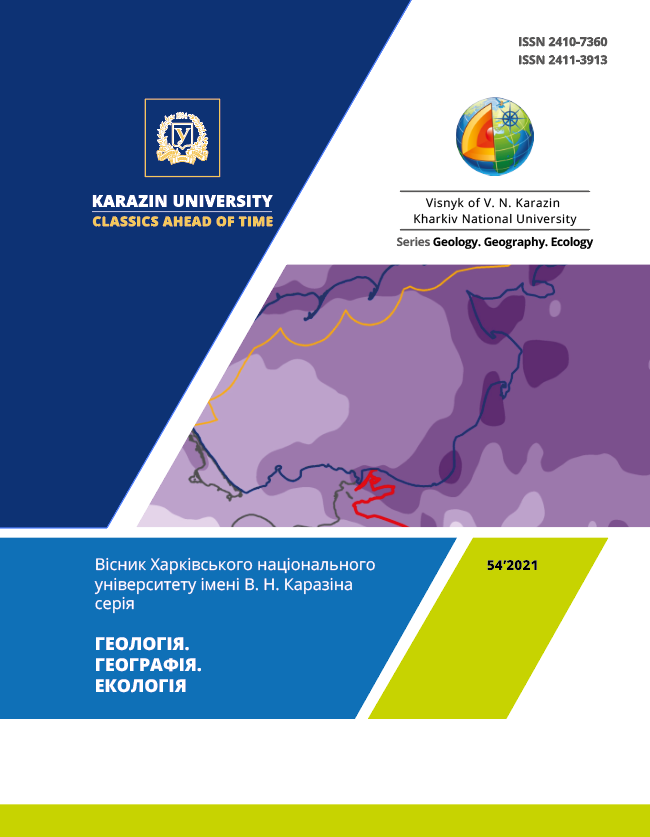Прогнозування водності річки Стир на найближчі роки
Анотація
Водний стік річки Стир використовується для потреб промисловості, сільського господарства та населення. В басейні р. Стир створено Хрінницьке та Млинівське водосховища, Хрінницька ГЕС, а також водою річки обслуговується Рівненська АЕС. Отже, довгострокове прогнозування водності р. Стир має важливе значення.
Найчастіше для довгострокового гідрологічного прогнозування використовують кількісні методи. Однак, гідрологічні прогнози, які мають завчасність рік, два або десятиліття мають низьку справджуваність. Сьогодні у світі ця проблема є не вирішеною. Разом з цим, для покращення довгострокового гідрологічного прогнозування отримують розвиток підходи, які використовують якісні методи. Отже, у роботі для довговстрокового прогнозування водності р. Стир використано метод співмірності, який за своєю сутністю є якісним методом. Метод співмірності дозволяє прогнозувати різні природні явища, зокрема землетруси, повені, посухи тощо. Він характеризується простотою обчислень та мінімальними потребами у вхідній інформації. Існує декілька способів прогнозування за методом співмірності. У роботі використано спосіб прогнозування за двовимірними графіками співмірності. Цей метод полягає у визначенні значень співмірності в масиві дат настання тих чи інших явищ та побудові двовимірного графіку співмірності, за яким і відбувається прогнозування.
Для прогнозування водності р. Стир на найближчі роки опрацьовано найтриваліший ряд спостережень на річці, а саме на гідрологічному посту р. Стир – м. Луцьк за період 1923-2017 рр. Результати дослідження за методикою співмірності показують, що водність річки Стир у 2020-2021 рр. має бути більшою за норму, у 2023-2024 рр. – меншою за норму.
Завантаження
Посилання
WMO (World Meteorological Organization) (2009). Guide to Hydrological Practices, Vol. II, Management of Wa-ter Resources and Application of Hydrological Practices, sixth edition, WMO-No. 168, World Meteorological Or-ganization, Geneva, Switzerland.
Zhu T., Marques G., Medellin-Azuara J. and Lund J. (2020). Water Management and Transfers Optimization with Probabilistic Seasonal Forecasts. EGU General Assembly 2020, Online, 4-8 May 2020, EGU2020-20981.
Anghileri, D., Voisin N., Castelletti A., Pianosi F., Nijssen B., and Lettenmaier D.P. (2016). Value of long-term streamflow forecasts to reservoir operations for water supplyin snow-dominated river catchments. Water Resour. Res., 52, 4209-4225 https://doi.org/10.1002/2015WR017864
Pekárová P., Miklánek P., Pekár J. (2007). Long-term Danube monthly discharge prognosis for the Bratislava sta-tion using stochastic models, Meteorologický časopis, 10, 211-218.
Peng Z., Zhang L., Yin J., Wang H. (2017). Commensurability-Based Flood Forecasting in Northeastern China. Pol. J. Environ. Stud., 26(6), 2689-2702 https://doi.org/10.15244/pjoes/73859
Shaw Elizabeth M., Beven Keith J., Chappell Nick A., Lamb Rob (2010). Hydrology in practice. Fourth Edition. CRC Press, 543.
Borys Khrystyuk (2014). The short-term forecast of the water levels in the Kiliya channel of the Danube River. En-ergetika, 60(1), 69-75 https://doi.org/10.6001/energetika.v60i1.2874 [in Russian]
Günter Blöschl (2006). Hydrologic synthesis: Across processes, places, and scales. Water Resources Research, 42(3), W03S02 https://doi.org/10.1029/2005WR004319
Hongyan L., Yuxin W., Xiubin L. (2011). Mechanism and Forecasting Methods for Severe Droughts and Floods in Songhua River Basin in China. Chin. Geogra. Sci., 21(5), 531-542 https://doi.org/10.1007/s11769-011-0492-y
Su Y.J. and Hu H. (2015). Application of Commensurability in Earthquake Prediction. International Journal of Geosciences, 6, 619-624 http://dx.doi.org/10.4236/ijg.2015.66049
Borys Khrystiuk, Liudmyla Gorbachova, Pavla Pekárová, Pavol Miklánek (2020). Application of the commensura-bility method for long-term forecasting of the highest summer floods on the Danube River at Bratislava. Meteorol-ogy Hydrology and Water Management. Research and Operational Applications, 8(1), 70-76 https://doi.org/10.26491/mhwm/114482
Borys Khrystiuk, Liudmyla Gorbachova (2019). Long-term forecasting of extraordinary spring floods by commen-surability method on the Dnipro River near Kyiv city, Ukraine. Environmental Research, Engineering and Man-agement, 75(2), 74-81 https://doi.org/10.5755/j01.erem.75.2.22683
Shevchenko O.L., Grebin V.V., Osadchyy V.I., Charnyy D.Z., Shym I.P. (2019). Resources changes of groundwater and interstratum water in the conditions of global climate warming. Hidrolohiiа, hidrokhimiiа i hidroekolohiiа, 3(54), 90-91. [in Ukrainian]
Konovalenko O., Dutko V., Vasylenko E. (2012). Spatial distribution of maximal spring runoff of the Styr Basin Rivers. Hidrolohiiа, hidrokhimiiа i hidroekolohiiа, 1(26), 69-75. [in Ukrainian]
Nabyvanets Ya.B., Gorbachova L.O., Korneev V.N. (2010). High spring and rain floods in the Styr River basin. Proceedings of Ukrainian Hydrometeorological Institute, 259, 217-230. [in Russian]
Kalinin М.Ya., Obodovskyy O.G. (eds.) (2003). Monitoring, use and management of water resources of the Pripyat basin. Mynsk, 269. [in Russian]
Vyshnevskyi V.I. (2000). Rivers and reservoirs of Ukraine. Condition and use. Kyiv, Vipol, 376. [in Ukrainian]
Weng W.B. (1984). Basis of Prediction Theory. Petroleum Industry Press, 45.
Standardization Administration of the People’s Republic of China (2009). GB/T 22484-2008, Standard for Hydro-logical Information and Hydrological Forecasting; Standards Press of China: Beijing, China.
Shakirzanova J. (2011) Forecasting of the maximum water flow of the spring flood in basin Dnieper with use of the automated program complexes. Hydrology, hydrochemistry, hydroecology, 4(25), 48-55. [in Ukrainian]





